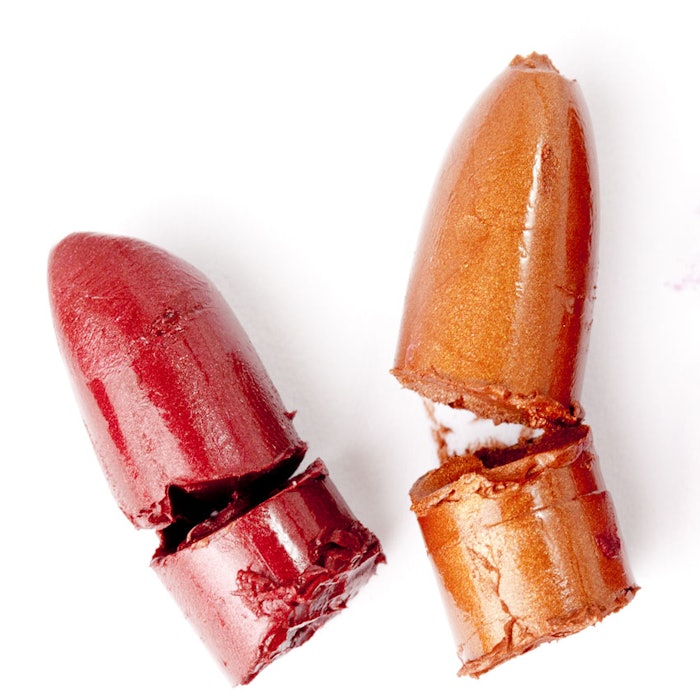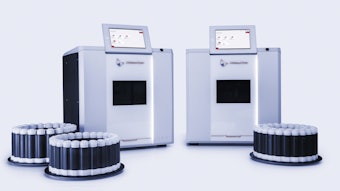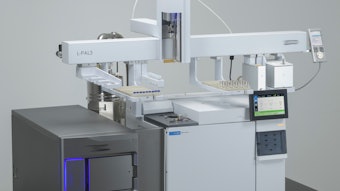
Human test panels traditionally are used to qualify new cosmetic products. The obvious advantage is their ability to make judgments on the broadest range of characteristics that will determine the success or failure of a new formulation. In particular, they can identify subjective qualities to conduct objective testing for physical behavior that may not be apparent when using instrumentation; for example, appearance in the container, ease of application, spreadability and retention of position/shape once applied.
At the same time, panels are expensive and may not always assess physical properties with as much certainty as instruments. Texture testers and rheometers (see Figure 1) have become common tools for R&D and quality control (QC) in the cosmetics industry, to assess the performance and flow behavior of products. Using these quick, simple devices to test lipsticks, powder compacts, mascara and lotion can not only characterize their flow behavior in R&D, but along with a comprehensive test for rheological performance, can lead to shortened versions of the test in QC.
One challenge in manufacturing is the variance in quality of raw materials; another is the mixing process. Mechanical tests for viscosity and texture will quickly identify batches of cosmetics and lotions that should be rejected or reworked. This brief overview provides examples of tests to evaluate and confirm the physical properties of products related to flow behavior.
Lipstick Bending
To test the strength of lipstick for eventual consumer application, a lipstick cantilever fixture is used with a texture analyzer. As Figure 2 shows, a “finger” probe attaches to the instrument and is vertically positioned above the lipstick sample. As the test begins, the probe is brought down into contact with the lipstick. It moves at a defined speed, for example, 0.5 mm/sec to 2.0 mm/sec, and pushes against the lipstick to a specified distance. The instrument measures the force in grams as the probe bends the lipstick, simulating the action of a person applying it. This measured value must fall between established limits in order to pass the test.
Powder Compact Integrity
To assess batches of powder compacts, a multiple probe assembly is used, also with a texture analyzer. Figure 3 shows how the probe is positioned above the powder sample at the start of test. The objective is then to move the probe downward to contact the powder at a low speed, ~1 mm/sec, and penetrate the surface. Again, the measured force must fall between established control limits.
If the force is too low, there may be air pockets or voids are in the sample, meaning it was not correctly filled. If the force is too high, the powder may not have the proper portion of ingredients in the mixture. This relatively quick test can help identify batches of powder that may not meet manufacturer specifications.
Mascara Application
To determine the yield stress of a mascara sample, i.e., the amount of force required by a consumer to apply the product, a controlled stress rheometer is used (see Figure 4). This applies torque to a cone spindle positioned over a mascara sample of small volume, usually < 1 mL. As the torque increases, the spindle will start to rotate slightly. The instrument also includes a temperature control plate so that the sample can be tested either at room temperature or human skin temperature. As with all the above tests, the yield stress must fall between established limits.
Lotion Rubbing
A rheometer can be used to perform standard shear ramp tests, e.g., rubbing a lotion or cream into skin; it also can test mascara. The procedure involves rotating the spindle at increasing speed, ~ 0 rpm to 100 rpm, and measuring the viscosity flow curve, as shown in Figure 5.
This indicates the shear-thinning behavior of the lotion, which tells the analyst what the customer will feel when they apply the lotion to their skin. As noted, the viscosity value at 100 rpm should also fall below a set limit in order for the sample to pass.
Instrument Advantages
The above tests give quantitative information about product flow behavior, making them ideal for use in QC departments where pass/fail measurements eliminate products that do not meet manufacturer performance specifications. This approach typically is less expensive and more objective than having individuals test random samples to subjectively decide if the product is acceptable.
However, the QC use of viscometers and texture analyzers is not necessarily “better” than human testing. The instruments are more practical for evaluating production batches of a product. One challenge in manufacturing is the variance in quality of raw materials used to make each product. Another is the mixing process that blends the materials into the finished product. Deviations from target control values can lead to a final product that may not meet marketing specs. Mechanical tests for physical properties like viscosity and texture will quickly identify batches of cosmetics and lotions that should be rejected or reworked.
An additional practical application for instruments is shelf-life testing. Cosmetics companies routinely process customer complaints for unacceptable products, and these devices allow sales and marketing to analyze returned field samples that have not met customer expectations. This answers the question of whether the problem occurred during original manufacturing, or while on shelf. A second set of tests for viscosity and texture analysis can focus on product stability during accelerated shelf-life testing, which at the very least serves to confirm customer complaints about poor product performance. It may also identify potential problems before they are initially reported by end users.
The root cause of a product failure can usually be traced back to original ingredient issues, manufacturing snafus, or improper handling/storage of product before purchase by a customer. The efficient use of viscometers and texture analyzers is therefore the cosmetic manufacturer’s solution for identifying potential problems before they become customer issues.










